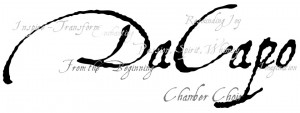One of the most beguiling things about the DaCapo Chamber Choir is that their director, Leonard Enns, assumes audiences handle an intellectually substantial and emotionally difficult program.
It is an approach more novel than it might initially seem.
Most programmers, labour under the assumption that audiences aren’t interested in anything unpleasant or unfamiliar. If bums in seats metric by which artistic success is measured, then Enns is definitely on to something.
The first and last concerts in the 2009/10 series explored the hope/despair dichotomy and the many faces of love.
While still quite abstract, the fundamental nature of these ideas makes them immediately resonant. Who among us hasn’t experienced some facet of love and loss?
Saturday’s concert at St John The Evangelist Church in Kitchener tested the limits of how equivocal a theme can be and still provide focus continuity. The concert was designed to explore the possibilities of the in-between, the “connective tissue,” as Enns described it in his remarks.
In most other DaCapo concerts, Enns uses an instrumentalist to connect the pieces together with short improvisations.
Saturday’s collaboration with percussionist Carol Baumann was the most effective to date. Concentrating on colour with bowed vibraphone,tam-tam, cymbals and shakers, Baumann created sonic palette cleansers that were completely unaffected.
She was careful to avoid any specific rhythm or harmonic commitments and wove the starting pitches for the choir in so subtly, it was unnoticeable.
The ethereal aesthetic and compound harmonies of modern choral compositions are enchanting. When taken in large quantities however, tend to melding into an ascetic wall of pleasant but ultimately meaningless dissonance.
For most of the first half it was difficult to find anything to connect with on an emotional level. Technically, DaCapo wasn’t quite up to their usual excellence. Some disagreement on interval width in the sopranos and a few sloppy ensemble moments are worth mentioning only because it is so unusual.
The opening piece of the second half, Past Life Melodies by Australian Sarah Hopkins, was different from the first notes.
DaCapo is becoming quite accomplished at overtone singing and the gossamer harmonics brought to mind the big, starry skies of the Outback. As often happens when you look up, I found myself contemplating the interconnectedness of life.
Although DaCapo’s remit is 20th and 21st-century pieces, Enns has been extending the choir’s repertoire ever so slightly in recent concerts. was these additions that grabbed my attention most firmly.
Bring us, O Lord God gave the choir a chance to leave behind the quiet restraint most modern music requires and luxuriate in the full acoustiof St John’s. The soaring climax in the last line was fantastic in the way that only Anglican church music can be.
Locus iste, a jaw-droppingly gorgeous motet by Anton Bruckner closed the program. In the notes Enns apologized to Bruckner for taking liberties in the last section.
He needn’t have. When the score is an inspiration rather than a shackle, magic happens.




